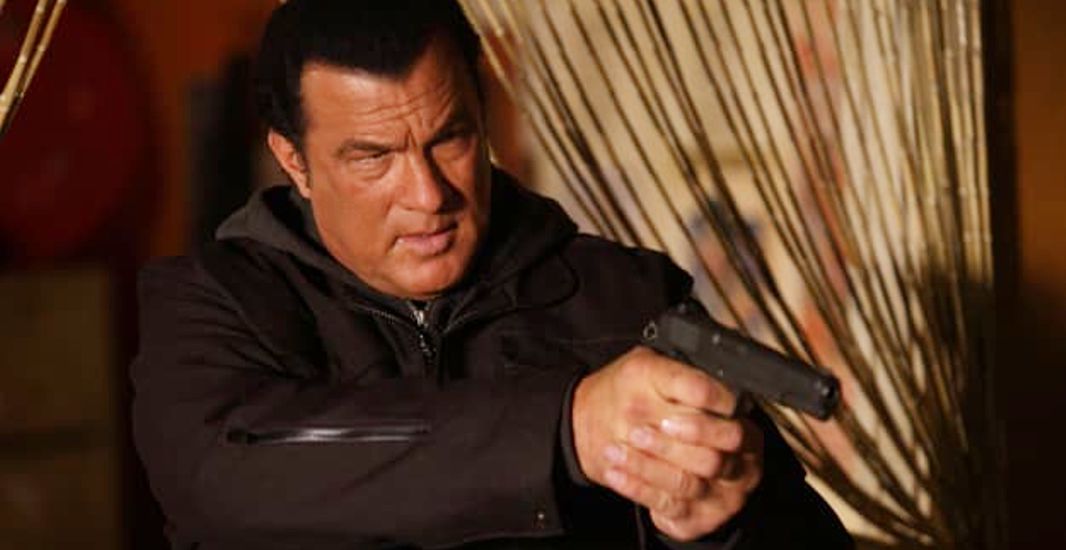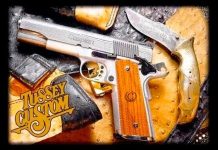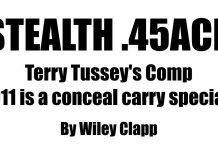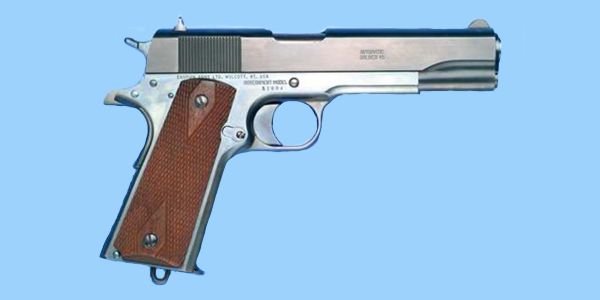
When even a Black Belt isn’t enough . . . The Custom Pistols of Steven Seagal
Believe it or not, there are still a lot of people running around who have never heard that old yoke about bringing a knife to a gunfight. I know this is true, because every time I mentioned working on this article about Steven Seagal’s shooting skills, someone would make the comment, “What does that guy need with a gun?”

They refer, of course, to the awesome martial arts skills possessed by the film superstar, most of which he has demonstrated on screen. I say “most” of the skills advisedly for a couple of reasons: First, while the fight scenes must certainly be choreographed for safety, Seagal does this himself to ensure the utmost in technical accuracy while still creating the excitement and action needed to make successful films; second, no world-class master of any legitimate style of martial arts would ever reveal all that he knows unless forced to use it! Even for $10,000,000 a picture.
Almost as a side note, that brings us to another frequent comment about those fight scenes that may reflect your own thoughts on the matter-that they are not near as flashy as other action movie fisticuffs. Well, in my opinion, you’re right – they’re not. However, there’s nothing pretty about a real fight, especially with highly trained combatants who have the ability to reduce the whole affair to one quick and effective move when everything goes right.
What you see in a Steven Seagal film is as real as it gets for the movies, which is high compliment considering some of the inane stuff produced by many others in Hollywood. Seagal also tries to bring this kind of realism to the guns and gunfight sequences in his films, and he does it the same way as the martial arts scenes-through personal knowledge and experience.
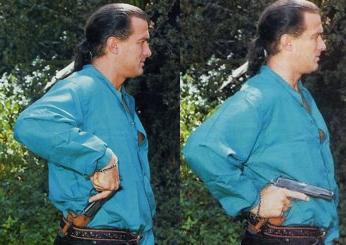
Speaking of those past experiences, Steven took a lot of heat from some self-appointed critics early in his career when it was reported he had claimed a past association with the CIA. He has tried to make it clear that he never made any such insinuation, but the press and broadcast media are not known for following up on facts that refute and deflate their previous sensational-but-erroneous stories. I only open this can of worms again to note that even 1 know better than to make such a ridiculous assertion for publication, and, having met Steven Seagal on other occasions, plus visiting with him for this article, my impression is that he’s been around enough to know the rules.
Hopefully, with this addition of my two cents worth, that’s finally enough said about that issue.
What is clear when you meet the man in person is that he knows what he’s doing with a firearm, to the extent that he has a well-developed set of personal standards when it comes to equipment, and a rigid training routine that echoes the dedication needed in the other martial arts disciplines he has mastered.
Here’s a brief summary of Seagal’s training/practice program, as described by him:
A. Dry-Fire
1 Lots and lots of it, especially when unable to do live fire practice.
B. Live-Fire practice
1. Begin at no more than seven yards distance, snap-shoot first round onto target, then “chase” the first bullet hole with the rest of the rounds in the pistol.
2. Repeat as needed (100-200 rounds minimum) until pistol is being emptied quickly without causing the first bullet hole to enlarge by any appreciable amount.
C. Continue Live-Fire practice
1. Extend shooting distance, begin with draw-and-fire drills and accelerate as quickly as possible without sacrificing smoothness or accuracy for speed.
2. Repeat as needed (200-400 rounds minimum) until all is right.
D. Close-Quarters, Multiple-Adversary and other specialized drills
1. Vary shooting distance from arm’s length to 50 yards and more, creating situations that require more than shooting skills to solve.
2. Repeat, repeat, repeat
Seagal says he tries to keep his handgun skills in tune with this regimen, firing up to 3,000 rounds a month when he has the time and opportunity to do so. It sounds like it ought to work! In fact, while it seems like a full-out training schedule for one of today’s top competition shooters, any athlete knows that this practice routine is the absolute minimum of time and repetition needed to imprint even the simplest physical skill into muscle memory-let alone something so complex in hand eye coordination and muscle control as quickly and accurately firing a powerful handgun.
I’m guessing while no one could reasonably doubt Seagal’s other martial skills, there are still a lot of people, avid fans included, who do wonder exactly what kind of shot this guy really is!
Well, while our schedules have never coincided to allow shared range time, 1 have it on good authority that Mr. Seagal is every bit the shootist he portrays on-screen, and maybe even more so! I had heard these reports earlier from several individuals who had seen Seagal shoot at one time or another, but the definitive evaluation finally came to me from my friend, pistolsmith Terry Tussey.
Tussey is an old hand around the Southern California shooting scene, having cut his teeth decades ago in the days of Jeff Cooper’s Big Bear Leatherslap Matches. Tussey dropped out of competitive shooting years ago, choosing instead to work his pistolsmithing magic on semi-autos and revolvers alike from his shop in Santa Ana, California. However, his withdrawal from competition has not served to blunt his shooting abilities one iota, and when this fellow who regularly humbles me at the range says Steven Seagal can shoot, I believe him!
How is it that Tussey is such an authority on Steven Seagal’s shooting abilities? Simple-Tussey has been working closely with the film star during the course of building several guns for him. This association has included a few shooting sessions at Seagal’s place in California’s Santa Ynez Valley, and a recent joint expedition to another site in Montana where Tussey’s prairie dog popping skills were tested along with his ability to shoot the pistols he had created at least as well as the customer for whom they were intended!
Reinforcing his appraisal of Seagal’s shooting, Tussey relates these stories: “On two occasions Steven has called to say he was not happy with a pistol. Both had failed to pass his first practice stage of “Chase the Bullet Hole.” Now, each gun would hold a tight and round cluster cutting Xs in the 10-ring at 25 yards when I tested them before delivery. The first time this happened I argued with him that he needed to try different ammo, or maybe just get used to a new gun. It only took once to prove to me there was something off-kilter, and the second time I just told him to send the gun back. In each case the barrel did prove to be slightly out of spec, but it took some time and sophisticated instruments to prove it . . . to everyone except Steven! He only needed to fire a few magazines full of ammo through each pistol before he was sure it wasn’t perfect. All he said was, `They’re not going where they’re supposed to, Terry.”‘ Tussey bemoaned the experience:
“Geez, I wish he’d shoot at bullseyes instead of bullet holes!”
Tussey went on: “Then, the last time we were at his place in Montana, we had set up targets at about 20 yards distance, intending to shoot pistols and also bring some freshly scoped rifles to a rough zero.”
“We had forgotten regular bullseye targets, so I left Steven at the shooting area and went back to the house for bullseye targets.” Tussey continued: “While at the house, I heard shooting and assumed Steven had started with the rifles, since we had hung only the diamond-pattern scope targets. As I returned to the range area, I saw Steven shooting a pistol, and without much thought I presumed he was plinking at something downrange. I started downrange with the bullseye targets and Steven handed me some fresh scope targets, saying I’d need to change those too. Arriving at the target board, I was surprised to find a large (read .45caliber) but single bullet hole in selected spots on several of the scope targets. There was one dead-center, one at each point of the diamond and one in the center of each of the smaller diamonds around the edge! Returning to the bench area behind the shooting line, I remarked to Steven how unusual it was to get a rifle bore-sighted that precisely, especially one with .458 bore like the Model 70 Safari that I thought he had used to so precisely drill the diamonds of the scope target. I complimented him on his marksmanship, asking if he had fired from the Sitting or Prone.”
Tussey laughs at himself here: “Hindsight makes it clear to me now that Steven didn’t at all understand my comments, and no wonder-not only had he yet to even shoulder a long gun that day, but he knew I had actually seen him shooting a pistol upon my return. He first gave me a look that could have meant one or all of many things (and probably did), then he explained that shooting the rifles was my job, and he had perforated the scope targets with a couple of .45s for something to do until I came back! I could tell he was talking slowly and choosing his words like one must do with a child. Having put my foot in it, it was time to backpedal. I would never want to insult any cordial fellow shooter, let alone a friend, by proclaiming that something they had just done was well beyond my opinion of their abilities.”
Tussey finished: “In this case, I certainly wasn’t discounting Steven’s ability to shoot that well, I just had not questioned my initial presumptions about where he was shooting when I saw him with the pistol. Anyway, before the whole deal turned into `Who’s on First?’ (with me playing Costello), I mumbled something about `movie superstars with no sense of humor’ and then toddled off to change the targets!”
Tussey and Seagal came together through a juxtaposition of mutual friends, myself included, but the mar riage was already made in heaven. I say that because Seagal is known as a very demanding character in any situation and is especially so when it comes to his handguns.
Tussey, on the other hand, frets about all his work as though every customer were Steven Seagal.
A good example of how one pistolsmith’s nightmare can be another’s challenge is Seagal’s wish to have the thumb safety fit as precisely as possible on his guns. Rather than come up with 10 reasons (legitimate or not) why it doesn’t matter, Tussey just smiles, welds up the front face of the part and then carefully hand-fits it to the slide of the particular gun. Can you say “customer satisfaction”?
Having verified that Seagal can shoot, let’s take a look at his checklist for a perfect business gun.
First, I suppose the photos have made it clear that Steven is a subscriber to the 1911 Club, and while we’ve all seen him wield an array of small arms on-screen, I have personally never seen him with anything but one (or more) of John Browning’s slab-sided masterpieces-and all in.45 ACID.
Second, the 1911 pistol residing in the Andy Anderson holster high on Seagal’s strong-side hip (or in a cross-draw Mexican Carry when problems seem especially imminent) will probably not look too impressive if passed to you for inspection. In fact, if it’s one of his favorites, you’re going to think it’s quite a plain-Jane piece at first glance. Look again, though, because if you know what’s up when it comes to a 1911-pattern pistol, you’ll quickly recognize an implement whose potential belies its rather mundane appearance.
The slide is flawlessly fitted to the frame; the barrel is not only tight, but also centered in the slide assembly; the trigger is safe but crisp at about four pounds let-off; and the simple but adequate high-visibility Millett fixed sights fill up your vision with a broad rear sight blade that perfectly frames the front sight for quick target acquisition and accurate shooting.
Seagal has little use on a serious business gun for all the modern and trick accessories some folks feel must be standard equipment on any pistol labeled “custom.” Steven rejects the normal extended safety/slide releases, and especially the raised magazine release buttons often seen. To him, these are cosmetic or competition-oriented. He also nixes luminous night sights, recoil spring guide rods and compensators when it’s all serious work.
Aligning himself with the rest of us traditionalists, Steven pays homage to the genius of John Browning, choosing not to try and second-guess the old boy about the design specifications for the perfect defensive handgun. That’s not to say that Seagal doesn’t own a few trick pistols, .45s of course, these being a collaboration between Caspian Arms and Tussey that are serial numbered “Seagal 1 ” to “Seagal 4.”
Seagal 1 is a precision business gun built by Tussey from all-Caspian components that the company sent as an introductory piece for Seagal’s evaluation. It seems that Gary Smith, one of the honchos at Caspian, had heard from other sources that Seagal was a celluloid hero who could actually perform in real life. Gary mentioned this to Tussey one day during the course of other business, at which point Terry related the anecdotes covered earlier. Smith immediately suggested that he provide the parts for Tussey to construct a pistol for Seagal, the only requested condition being that Steven then give the finished piece a lengthy and thorough shooting evaluation, and to relay his critique and opinions of the Caspian products to the company via Tussey as a part of their ongoing quality control and product development programs.
Seagal 1 was a big hit with the guy mentioned in the serial number, so other guns followed. Pictured here, these include a long-slide model, a new high-capacity Caspian frame with a Government Model Hybrid top-end and, last but cutest, an Officer’s-sized pocket gun with a proportionately reduced Hybrid compensating system.
Seagal has nothing but praise for the Caspian products. You can tell he has a genuine appreciation for their basic quality and in turn the finished guns created by Tussey, especially the long-slide, which has become one of his favorites.
At our request, Steven demonstrated his Draw and Shooting Stance. While doing so, Seagal explained that the shooting stance he uses is essentially a slight modification of a basic Samurai swordfighting position. The primary difference as he explained it is in the alignment of the feet in relationship to the target, which creates a better natural body alignment to the target’s center of mass. Upper torso posture is similar to some of the thrusting/advancing Samurai techniques, wherein there is a slight forward cant of the upper body from the waist.
This delivers the balance to the lower body and also eliminates any shifting and pivoting of the spine/shoulders that a totally upright body would experience when defending against a vicious slash of the sword …or when handling the recoil from a powerful handgun. The firearm is held with the shooting arm slightly bent, which is resisting the backward pull introduced by the other arm, creating isometric tension. The supporting hand circles around in front of the shooting hand, wrapping the fingers into the inter-finger grooves of the shooting hand, and both hands squeeze firmly.
Seagal’s draw is executed with the arm brought to the body, then moving forward to guide the hand onto the grip. This simple element of a good draw is very often overlooked, and it always amazes me when I see law enforcement or competition shooters “stabbing” that gun hand down from some undetermined start point toward an unseen object that is hung from their belt. The only thing worse is when the party in question has missed enough to know what to expect, so they turn their faces down and away from the target/adversary and look at what they’re doing!
Once his gun hand seats itself into the “saddle,” the pistol is raised only enough to snatch it just clear of the holster, and then it is brought straight forward and out as though Seagal were punching the gun’s muzzle through the target. This technique is not only fast and accurate, it also prevents “painting” the area with the muzzle while trying to get the firearm into action-a common error in real-life situations.
Once he had drawn and presented, Seagal moved quickly and effortlessly to demonstrate a high and low Ready. Going to full speed, he then addressed several imaginary targets about the room, and his actions became little more than a blur, even in person. Lordy, the guy can move!
So then, I hope this article will shed some light on the question of Steven Seagal’s real level of trigger savvy for those of you who have been curious about it. For those dour souls who can’t stand anyone else’s success and had hoped I would expose a seam in the armor, sorry, but the man can shoot.
Better than that, he is one of the few high-profile celebrities around that is not afraid to be known as a shooter and gun owner. Seagal clearly doesn’t give a rat’s flying fanny about how the meek view the “political correctness” of his actions, and it hasn’t hurt him at the box office. Steven has attended the NRA’s Charlton Heston Celebrity Shoot when possible, and he is quick to stand and be counted with those of us who believe in the Bill of Rights.
As far as I’m concerned, that’s the highest praise I can offer.
When even a Black Belt isn’t enough . . . The Custom Pistols of Steven Seagal
By Paul Hantke
Handguns Magazine”
January 1995

